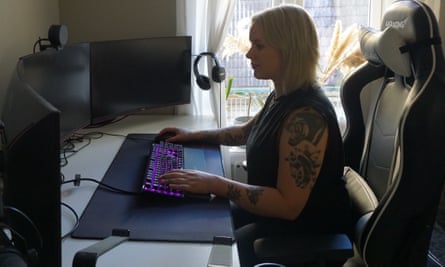‘They said: aren’t you that porn star?’ The woman hunting down image-based abuse | Sexual harassment
“Faces of exes,” Mia Landsem read out loud, as she clicked on a link to a forum exposing intimate images of ex-girlfriends, her frowning brow illuminated by a three-screen computer. On the 25-year-old’s neck, underneath wisps of blond hair, are tattooed reminders in Norwegian to be “brave” and “don’t give a fuck.” An internet security expert by day, by night she has made it her mission to hunt down and report such images from her apartment in Oslo. “I try to focus on the worst ones,” she said. “I can maybe get a few groups removed in a day, but then 20 more appear.”
Digital image-based sexual abuse – a catch-all phrase that includes deepfake pornography, so-called “upskirting” and “revenge porn”, a term rejected by activists for implying the victim has done something wrong – is a global problem on the rise. Almost three out of four victims are women, according to a 2019 study by the University of Exeter. But there are male victims and female perpetrators.
Catching digital perpetrators was, in Landsem’s own words, initially a way to stay alive. At 18, she was at a bar in the Norwegian city of Trondheim when she noticed a group of guys sniggering at her. When she asked what was so funny, they said: “Aren’t you that porn star?” Landsem recalled. “I didn’t understand anything. Then they showed me that photo.”
In it, Landsem and her ex-boyfriend were having sex. She was 16 at the time. “I remember running to the toilet of the bar and crying,” Landsem said. Seeing how distressed she was, the men deleted the image. But it was already making the rounds of the city.
Although it is difficult to pin down how widespread digital intimate image-based abuse is, aid organisations in several countries reported that it exploded during the pandemic. “We’re seeing more and more content,” said Sophie Mortimer, manager at the UK Revenge Porn Helpline, whose caseload surged to a record of 3,146 cases in 2020. “We need to act in a global manner,” Mortimer said. “Because that’s how the internet works, it is a global thing.”
Victims are often left to fight their battles alone due to what lawyers, scholars, psychologists and activists interviewed across Europe for this article deplored as a lack of will to prosecute the crime and to regulate tech companies.
Landsem said she never charges victims for her help, whether they are 12-year-olds or celebrities. “No one should have to pay for this,” she said.
Most evenings, she spends hours going through her emails, responding to desperate requests for help. She also has hundreds of bots set up across the internet, alerting her to when new groups form so that she can report them. “If there’s a crime scene and someone is murdering someone, you have to gather the evidence right after it happened,” she said. “That’s why I try to help with the most basic evidence I’m allowed to gather, and I give it to the police to make them work a bit faster.” She sometimes uses fake identities to join closed groups, taking screenshots along her way that she sends to the police and to the tech platforms. Among the other digital evidence she collects are user names, IP addresses, URLs and the metadata from the images themselves – which can include when and where the photograph was taken, and on what device.

What people often fail to understand, Landsem said, is how common it is to upload nude images of others without their consent – especially among teenagers. (According to the Norwegian police, digital image-based sexual abuse becomes a problem at the age of 12-13.) “I wouldn’t call it a subculture, it’s everyone,” Landsem said.
One of the first people to spread Landsem’s image was her former best friend. The two young women had fallen out at the time. One day, Anne Fredriksen received a message from Landsem’s ex. “He said, it would be fun if this came out,” Fredriksen recalled. “If I had known that people exchange images like they are trading pokémon cards, I would never have done it.”
The UK Revenge Porn Helpline has called this “collector culture”. “One underexplored aspect is that it has become a kind of hobby,” said Julia Słupska, a cybersecurity doctorate at the Oxford Internet Institute. Ruth Lewis, a sociologist and co-author of Digital Gender-Sexual Violations, found that men who engaged in so-called “upskirting” – taking a picture up the skirt of a woman without her consent – wanted “to get kudos from other men for taking great photos that are risky” without being caught. “The woman is almost immaterial,” she said. “She’s just currency.”
Clare McGlynn, a law professor at Durham University, described digital image-based sexual abuse as “about a masculine culture that rewards treating women not very well.” “It’s about power and control,” she said. “The partner that would take a picture of someone in the shower and then pass it to someone else, it is just because they can, they want to.”
In a Norwegian group on the encrypted messaging platform Telegram – a favoured service for those seeking anonymity – a user encouraged the nearly 900 members to “share what you have”. Users requested specific names of women – “anyone got … ?” – but also geographical areas (regions, cities, or even schools). “If anyone wants to trade, DM,” wrote another. Some had joined using their full names and turned out to be in high school. We contacted three group members, none of which accepted an interview for this article.

Maëlle Chiarolini was 14 when a video of her and her ex-boyfriend having sex made the rounds of online groups, available to see for everyone at her school in Belgium. Her mother, Zara Chiarolini, was oblivious to what was going on. “She didn’t want to go to school, she had stomach pains,” Chiarolini said. Maëlle went from being a cheery teenager who loved boxing to snapping at her mother and hiding her phone.
A couple of months later, in January 2020, Maëlle took her own life. “Maëlle ended her life because she didn’t see a solution, she didn’t see who she could talk to about this,” her mother said. Chiarolini joined a group working to help children who are victims of cyberbullying. “We must work on turning the shame around,” she said. “It’s the perpetrator who should be ashamed, not the victims.”
Shame is an important reason why victims are reluctant to seek justice, according to lawyers, scholars and activists interviewed for this article. It took Landsem nearly two years before she reported her ex-boyfriend. When she did, she included proof of him admitting to the crime. “I served the police the case on a golden plate,” Landsem said. Months later, the police dropped the case. “I was very depressed, I didn’t want anyone else to experience that. I started looking at the legislation, how to help others so that they wouldn’t have to be called a porn star on a night out.” (In the end, Landsem’s ex got fined for spreading pornography.)
Landsem’s digital detective skills would help pivot the Norwegian approach to digital image-based abuse. In 2017, she discovered several nude images of Nora Mørk, a handball player on the national team. The case kickstarted a national debate and, in the summer of 2021, Norway made the spread of intimate images a crime punishable with up to one year of imprisonment – two if the abuse is “systematic” or “organised.”
In the UK, convicting someone for intimate image-based abuse requires proof of intent to cause distress, which makes it a tough crime to prosecute. But even countries with laws in place struggle to take cases to court. In France, spreading intimate images of someone without their consent is punishable with up to two years in prison and €60,000 fine. Unfortunately, said Rachel-Flore Pardo, a lawyer and co-founder of the organisation Stop Fisha, which helps victims of digital image-based abuse, the law is not adequately implemented yet.
Activists such as Pardo believe tech platforms need to do more. This spring, the EU came close to adopting a landmark law that would have increased pressure on websites publishing pornographic content. But during the final stretch of late-night political haggling, the relevant article 24b of the Digital Services Act (DSA) disappeared from the text.
“No one was willing to fight for it,” said Alexandra Geese, a Green MEP who campaigned to get the measure through. “You know, it’s just women, who cares? It’s not business. It’s not important.” A European directive against violence against women is currently in the works, but, according to Geese, “it does not bite.” Victims, she said, would still be left with the burden of chasing down the images and proving who uploaded them, “which is impossible, basically.”
Prosecuting image-based sexual abuse is tricky, not least because of its prevalence. Inside the headquarters of Kripos, the Norwegian national unit specialised in sexual abuse of children, police officers sift through thousands of images every year.
Kripos’ superintendent, Helge Haugland, said international cooperation was key in order to successfully prosecute digital image-based abuse, and welcomed that an increasing number of platforms were seeking to join efforts to alert authorities to abusive material. But “it would be easier for us if there was one way to ask all the companies for data, instead of it being up to the tech platforms,” Haugland said.
It is in this emerging field that people like Landsem are operating, though Haugland warned that well-intentioned hacktivists could hinder police operations and, if operating illegally, fail to produce evidence that could be used in court. Landsem, who says she never does anything illegal, is well aware of the tension. “It’s the hardest part of my job,” she said about doing nothing, when she knows she could do something. “It feels like someone is being murdered, and I’m watching.”
This work was co-funded by the Journalism Fund.
The UK Revenge Porn Helpline can be contacted on 0345 6000 459 or online at revengepornhelpline.org.uk